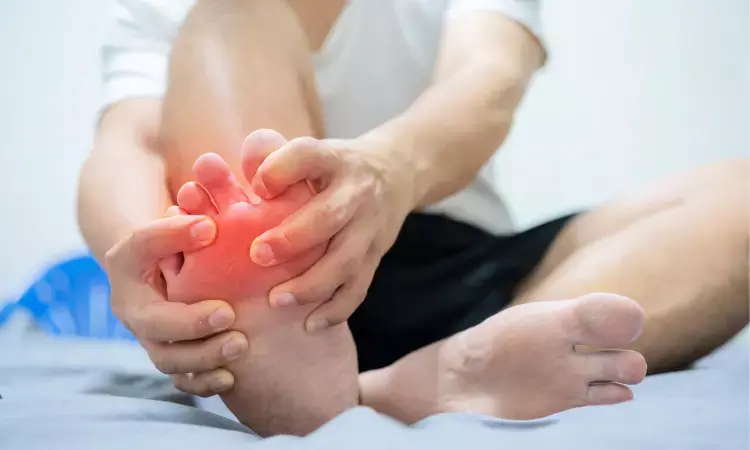- Home
- Medical news & Guidelines
- Anesthesiology
- Cardiology and CTVS
- Critical Care
- Dentistry
- Dermatology
- Diabetes and Endocrinology
- ENT
- Gastroenterology
- Medicine
- Nephrology
- Neurology
- Obstretics-Gynaecology
- Oncology
- Ophthalmology
- Orthopaedics
- Pediatrics-Neonatology
- Psychiatry
- Pulmonology
- Radiology
- Surgery
- Urology
- Laboratory Medicine
- Diet
- Nursing
- Paramedical
- Physiotherapy
- Health news
- Fact Check
- Bone Health Fact Check
- Brain Health Fact Check
- Cancer Related Fact Check
- Child Care Fact Check
- Dental and oral health fact check
- Diabetes and metabolic health fact check
- Diet and Nutrition Fact Check
- Eye and ENT Care Fact Check
- Fitness fact check
- Gut health fact check
- Heart health fact check
- Kidney health fact check
- Medical education fact check
- Men's health fact check
- Respiratory fact check
- Skin and hair care fact check
- Vaccine and Immunization fact check
- Women's health fact check
- AYUSH
- State News
- Andaman and Nicobar Islands
- Andhra Pradesh
- Arunachal Pradesh
- Assam
- Bihar
- Chandigarh
- Chattisgarh
- Dadra and Nagar Haveli
- Daman and Diu
- Delhi
- Goa
- Gujarat
- Haryana
- Himachal Pradesh
- Jammu & Kashmir
- Jharkhand
- Karnataka
- Kerala
- Ladakh
- Lakshadweep
- Madhya Pradesh
- Maharashtra
- Manipur
- Meghalaya
- Mizoram
- Nagaland
- Odisha
- Puducherry
- Punjab
- Rajasthan
- Sikkim
- Tamil Nadu
- Telangana
- Tripura
- Uttar Pradesh
- Uttrakhand
- West Bengal
- Medical Education
- Industry
Obesity Reduces Effectiveness of Febuxostat in Gout Treatment, Study Finds

China: A recent prospective cohort study has revealed that obesity significantly reduces the effectiveness of febuxostat-based urate-lowering therapy (ULT) in male patients with primary gout, highlighting the need for tailored treatment approaches for individuals with obesity.
"At 12 weeks, only 38.9% of the obese group achieved a serum urate (SU) level of <6.0 mg/dL, compared to 54.2% of the overweight group and 63.8% of those with normal weight. Additionally, both obese and overweight individuals experienced higher rates of gout flares, emphasizing the importance of addressing weight management in gout treatment," the researchers reported in the journal Rheumatology.
Gout, a form of inflammatory arthritis, occurs when uric acid crystals accumulate in the joints, causing intense pain and swelling. To manage this condition, urate-lowering therapy (ULT) is commonly prescribed to reduce uric acid levels and prevent recurrent gout attacks. Among the medications used to lower uric acid, febuxostat is one of the most frequently prescribed and has proven effective for many patients. However, while obesity affects 53% of gout patients, the impact of obesity on the effectiveness of ULT, particularly febuxostat, remains unclear. Understanding this relationship is crucial for optimizing treatment strategies for gout patients, especially those with obesity.
To fill this knowledge gap, Zan Cheng, Department of Endocrinology and Metabolism, the Affiliated Hospital of Qingdao University, Qingdao, China, and colleagues aimed to compare the response to febuxostat across different body mass index (BMI) categories in male gout patients.
For this purpose, the researchers conducted a prospective study involving 633 men with gout, who were classified into normal-weight, overweight, and obese groups based on their BMI. Baseline characteristics, including age, disease duration, and SU levels, were matched across the groups. All participants received febuxostat for 12 weeks, with the dosage gradually increased from 20 to 40 mg daily. The researchers compared the efficacy of urate-lowering therapy and the incidence of gout flares among the three groups.
Cox regression analysis was employed to identify risk factors for achieving target SU levels before and after matching. Additionally, restricted cubic spline (RCS) curves were utilized to illustrate the relationship between BMI and the hazard ratio (HR) for achieving target SU levels.
The following were the key findings of the study:
- The proportion of participants achieving SU < 6.0 mg/dL in the obese group was 38.9%, significantly lower than the 54.2% in the overweight group and 63.8% in the normal-weight group.
- There was no significant difference between the overweight and normal-weight groups at week 12.
- High BMI independently prevented achieving the SU target, with a hazard ratio (HR) of 0.92, and this effect remained consistent after matching.
- Obese and overweight individuals experienced a higher cumulative incidence of gout flares compared to the normal-weight group.
- RCS analysis suggested a linear relationship between BMI and HR for achieving the SU target, with no significant nonlinear effect.
"The findings showed that obesity significantly diminishes the effectiveness of febuxostat-based urate-lowering therapy in male gout patients, with a greater impact than being overweight," the researchers concluded.
Reference:
Cheng, Z., Xu, X., Qi, H., Li, X., Li, Y., Jiang, C., Miao, X., Ji, X., Wang, Y., Dong, B., Li, C., & Lu, J. Obesity reduces the urate-lowering efficacy among patients with primary gout: A prospective cohort study. Rheumatology. https://doi.org/10.1093/rheumatology/keaf076
Dr Kamal Kant Kohli-MBBS, DTCD- a chest specialist with more than 30 years of practice and a flair for writing clinical articles, Dr Kamal Kant Kohli joined Medical Dialogues as a Chief Editor of Medical News. Besides writing articles, as an editor, he proofreads and verifies all the medical content published on Medical Dialogues including those coming from journals, studies,medical conferences,guidelines etc. Email: drkohli@medicaldialogues.in. Contact no. 011-43720751


